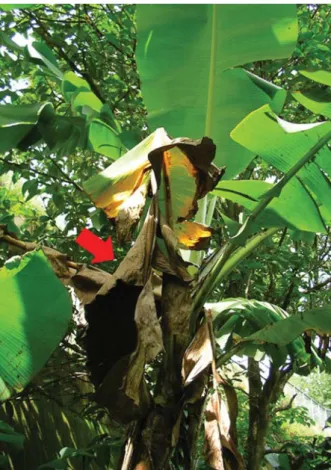台灣管鼻蝠(Murina puta)棲居於香蕉葉之發現紀錄
Furled Banana Leaves as Roost for the Formosan
Tube-nosed Bat (Murina puta)
周政翰
1徐昭龍
1莊孟憲
2李玲玲
3,*Cheng-Han Chou
1, Chao-Lung Hsu
1, Meng-Hsien Chuang
2and Ling-Ling Lee
3,*1台灣蝙蝠學會 台北市漢口街二段 90 巷 2 號 2 樓
2私立真理大學自然資源應用學系 台南縣麻豆鎮北勢里北勢寮 70-11 號 3國立台灣大學生態學與演化生物學研究所 台北市羅斯福路四段 1 號
1Bat Association of Taiwan, Taipei, Taiwan
2Department of Applied Natural Resources, Aletheia University, Tainan, Taiwan 3Institute of Ecology and Evolutionary Biology, National Taiwan University, Taipei, Taiwan
* 通訊作者 * Corresponding author
摘
要
蝙蝠棲所類型多樣,包含洞穴、人工建物及植物等。台灣已知至少有 37 種蝙蝠,但僅發現 8 種蝙蝠利用洞穴型棲所,7 種利用人工建築物,8 種利用植物棲所。台灣管鼻蝠為台灣特有種, 屬森林性蝙蝠,昔日對於其棲居何處並不清楚。本文描述 2006 年 6 月在台南縣大內鄉一處雜木 林地,發現其使用位於約 2.5m 高的香蕉捲曲枯葉做為棲所,棲所內有 1 成體及 2 幼體棲息,此 為台灣管鼻蝠香蕉葉棲所的首次發現紀錄。Abstract
Taiwan, eight roosts in caves, seven in buildings, and another eight on plants. Murina puta is a forest-dweller and an endemic species to Taiwan. An adult and two juveniles of this bat were found to roost in furled leaves of a banana plant in a mixed forest at Danei Village, Tainan County. The leaves were 2.5m above the ground. This paper constitutes the first record of furled banana leaves as a roosting site for Murina puta.
關鍵詞:台灣管鼻蝠、棲所、香蕉、蜷曲葉、葉棲所
Key words: Murina puta, roost, banana plant, furled leaves, leaf roost
收件日期:96 年 5 月 21 日 接受日期:96 年 11 月 23 日
Received: May 21, 2007 Accepted: November 23, 2007
蝙蝠利用多樣的天然或人為環境作為其棲 息之用,這些蝙蝠棲息的地方統稱為蝙蝠的棲 所(roost)。蝙蝠在棲所中渡過一生大部分的時 間,並且 在 棲 所 進 行 休 息、交 配、育 幼 與 冬 眠。此外,棲所還提供保護,保護蝙蝠不被惡 劣天候與天敵的干擾與威脅(Kunz 1982)。蝙蝠 的生存與繁殖和棲所優劣息息相關,是故環境 中合適棲所的數量也是影響蝙蝠生存與繁殖最 重要的因子之一(Humphrey 1975;Bell et al. 1986)。 蝙蝠棲所主要可分為 3 個類型,分述如下: 1. 洞穴型(泛指天然或人工引水渠道、隧道及 天然洞穴…等) 一般而言,洞穴型棲所有較穩定之微氣 候,其溫濕度較洞外環境穩定,被蝙蝠使用的 期限也較其他類型長。在洞穴中棲息的蝙蝠群 體數量一般較大,最多可超過千萬隻(Davis et
al. 1962; Dwyer and Hamilton-Smith 1965),不
同季節與生長狀態的蝙蝠,也會有不同的洞穴 選擇,因此蝙蝠的洞穴棲所又可區分為夏棲洞 穴、冬眠洞穴或繁殖洞穴。 2. 人工建築物(指民宅、山屋、涼亭…等人為 建築物) 蝙蝠會選擇利用建築物之裂縫或掩蔽物作 為棲息之用,此種棲所使用年限亦屬長期,而 棲息的群體數量從數十到百隻不等。 3. 植物(泛指枯葉、樹皮裂縫、倒木、樹洞… 等植物體之任何構造) 此類型棲所可區分為蝙蝠自行選擇植物搭 建棲所,或隨機尋找現成可利用之植物體或樹 葉。自行建造棲所時,蝙蝠會將植物葉之基部 或中央部位,稍稍的破壞,讓葉子下垂形成類 似帳棚之構造,以便棲息(Rickart et al. 1989)。 此種棲所一般使用年限較隨機選取者長,而群 體數量從數百到千隻不等。蝙蝠使用隨機選擇 現成的植物棲所時,會選擇植物葉基部,或植 物所構成之穴狀物(樹洞或竹筒),此種棲所使 用時間短,而群體組成數量多半少於 50 隻個 體(Mattson et al. 1996; Crampton and Barclay 1998; Menzel et al. 2001)。
目前台灣已知 37 種蝙蝠中(Hsu and Lee 2007),利用洞穴型棲所的物種包含葉鼻蝠科
之台灣葉鼻蝠(Hipposideros terasensis)及無尾 葉鼻蝠(Coelops frithi formosanus),蹄鼻蝠科 之台灣小蹄鼻蝠(Rhinolophus monoceros)及台 灣大蹄鼻蝠(Rhinolophus formosae),蝙蝠科之 摺翅蝠(Miniopterus schreibersii)、台灣鼠耳蝠 (Myotis taiwanensis)、高山鼠耳蝠(Myotis sp.1) 及大足寬吻鼠耳蝠(Myotis sp.2) (周 2004),共 計 8 種。利用人工建築作為棲所的物種包含蝙 蝠科之東亞家蝠(Pipistrellus abramus)、高頭 蝠(Scotophilus kuhlii)、金 黃 鼠 耳 蝠(Myotis
flavus)、高 山 鼠 耳 蝠,葉 鼻 蝠 科 之 台 灣 葉 鼻
蝠,蹄鼻蝠科之台灣大蹄鼻蝠、台灣小蹄鼻蝠 (Rhinolophus monoceros)共計 7 種。另台灣狐 蝠(Pteropus dasymallus formosus)、金 黃 鼠 耳 蝠、渡瀨氏鼠耳蝠(Myotis watasei)、台灣彩蝠
(Kerivoula sp.)、棕蝠(Eptesicus serotinus)、高 頭 蝠、東 亞 家 蝠 (李 等 2006)及 長 尾 鼠 耳 蝠 (Myotis sp.3) (張 2006)等 8 種蝙蝠曾被發現其 利用植物做為棲所,其中僅金黃鼠耳蝠會利用 樹葉作為棲息及繁殖育幼的場所(張 2007)。 台灣管鼻蝠(Murina puta)為台灣特有種, 屬於中型管鼻蝠屬物種,前臂長為 33.5-38.6 mm,廣泛分布於台灣全島之山區森林,海拔 範圍為 200-2,500m (郭 2004)。台灣蝙蝠學會 於 2006 年在台南縣大內鄉二溪村進行蝙蝠調 查,於一香蕉樹上發現 3 隻台灣管鼻蝠,包括 1 雌性成體與 2 雄性亞成體,利用枯黃綣曲的 香蕉葉內側棲息(圖 1,2)。 此香蕉植株高度 約為 6m,而蝙蝠棲息處約為 2.5m (圖 3)。 圖 1. 台灣管鼻蝠棲息之蜷曲香蕉葉外觀。紅色箭頭處為蝙蝠棲息利用之蜷曲葉。
圖 2. 台灣管鼻蝠利用蜷曲葉狀況。毛色黃色為雌性成蝠,毛色棕灰色為幼蝠。
Fig. 2. An adult female (yellow fur) and two juveniles (gray fur) of Murina puta roosting in the furled
banana leaves.
圖 3. 台灣管鼻蝠蜷曲香蕉葉棲所離地位置約 2.5m。
Fig. 3. The height of 2.5 m above the ground for the furled banana leaves roosted by Murina puta.
國外文獻曾記錄會利用蜷曲葉(furled leaves) 棲息的蝙蝠種類包括數種鼠耳蝠屬的 Myotis
bocagei 與 M. mystacinus (Broseet 1976; Medway
and Happold 1990, 1996 )。這些種類往往有著 特化的身體構造(諸如膨大似吸盤的拇指基部 或特化的腳掌結構),以利棲息於香蕉葉上。 但棲居於這類型棲所的蝙蝠,多是利用野生香 蕉樹新生開口朝上的蜷曲葉,並棲息於蜷曲葉 基部,因此一群棲息在一起的個體數目都局限 在 10 隻以內(Findly and Wilson 1974; Medway 1983; Happold and Happold 1990)。此外,由 於新生蜷曲葉存在的時間很短(約 1-3 天),是 故利用此類型棲所蝙蝠需時常更換其棲所(Findly and Wilson 1974; Brosset 1976; Happold and Happold 1990, 1996)。本文中所描述的香蕉葉 棲所於發現此現象 1 週後檢視其利用狀態,發 現已無蝙蝠利用此植株之蜷曲葉,此與文獻中 所指僅會短暫利用此類型棲所的現象相同。 本文所記錄的台灣管鼻蝠其外部形態並無 明顯特化適於棲息此類棲所的結構;而其所利 用的為枯黃蜷曲的香蕉葉,棲息於蜷曲葉錐體 端,開口朝下。香蕉葉中僅發現 3 隻台灣管鼻 蝠棲息的現象與其他研究紀錄,蜷曲葉棲所中 棲息的個體數通常不超過 10 隻的現象相符, 並與家蝠屬物種 P. nanus 於繁殖季時,利用香 蕉葉的群體主要為母蝠與幼蝠構成的現象類 似(Happold and Happold 1990, 1996)。
此外,在 此次 調 查 紀 錄 中,利 用 豎 琴 網 (Harptrap)捕捉,共計捕獲 6 隻台灣管鼻蝠, 分別為 2 隻哺育後期的雌性成蝠與 4 隻雄性幼 蝠,而郭(2004)之解剖資料也提出台灣管鼻蝠 有雙胚胎,是故推測台灣管鼻蝠 1 胎可生育 2 幼蝠,且每年 6 月應為台灣管鼻蝠幼蝠離巢學 飛的季節。本文所描述台灣管鼻蝠利用香蕉葉 為棲所是台灣地區首次發現紀錄,推論台灣管 鼻蝠與金黃鼠耳蝠有類似的棲所利用狀況,並 利用香蕉葉作為棲息與繁殖育幼的處所。
謝
誌
感謝台南縣曲溪社區發展協會營造員金士 奐女士,協助當地調查及相關資料蒐集。引用文獻
周政翰。2004。台灣地區鼠耳蝠屬分類地位。 私立東海大學碩士論文。 郭浩志。2004。台灣地區管鼻蝠屬蝙蝠的系統 分類學研究。國立台灣大學碩士論文。 張仕緯。2006。鼠耳蝠 Myotis sp. 3 日間棲所 的 發現 紀 錄。野 生 動物 保 育彙 報 及通 訊 10: 14-15。 張恆嘉。2007。金黃鼠耳蝠在台灣西南部城鄉 林地之棲所選擇與數量變動。私立靜宜大 學碩士論文。 李玲玲、徐昭龍、周政翰、李秉容、胡伯齊。 2006。金門地區蝙蝠相調查研究。金門國 家公園管理處。Bell, G. P., G. A. Bartholomew and K. A. Nagy. 1986. The roles of energetics, water economy, foraging behavior, and geothermal refugia in the distribution of the bat, Macrotis
californicus. Journal of Biochemistry Physiology
B 156: 441-450.
Brosset, A. 1976. Social organization in the African bat, Myotis bocagei. Zeitschrift fur Tier-psychologie 42: 50-56.
Crampton, L. H. and R. M. R. Braclay.1998. Selection of roosting and foraging habitat by bats in different-aged aspen mixed-wood stands. Conservation Biology 12: 1347-1358. Davis, R. B., C. F. Herreid and H. L. Short.1962. Mexican free-tailed bats in Taxas. Ecological Monographs 32: 311-346.
Dwyer, P. D. and E. Hamilton-Smith. 1965. Breeding caves and maternity colonies of the bent-winged bat in south-eastern Australia. Journal of Australasian Speleological Research 4: 3-21
Findley, J. S. and D. E. Wilson. 1974. Observations on Neotropical disk-winged bats, Thyroptera
tricolor Spix. Journal of Mammalogy 55:
562-571.
Humphrey, S. R. 1975. Nursery roosts and community diversity of Nearctic bats. Journal of Mammalogy 56: 321-346.
Happold, D. C. D. and M. Happold. 1990. The domiciles, reproduction, social organization and sex ratios of the banana bat Pipistrellus
nanus (Chiroptera, Vespertilionida) in Malawi.
Zeitschrift fur Saugetierkunde 55: 145-160. Happold, D. C. D. and M. Happold. 1996. The social organization and population dynamics of leaf-roosting banana bats, Pipistrellus
nanus (Chiroptera, Vespertilionida) in Malawi,
east-central Africa. Mammalia 60: 517-544. Hsu, Chao-Lung and L. L. Lee. 2007. Bat diversity and conservation in Taiwan. Abstract of the plenary, symposium, poster and oral papers presented at First International South-East Asian Bat Conference: 98.
Kunz, T. H. 1982. Roosting Ecology. pp.1-46. In: T. H. Kunz (ed.). Ecology of Bats. Plenum Publishing Corporation, New York, United States. Medway, L. 1983. The Wild Mammals of Malays. Second ed. Qxford University Press, Kuala Lumpur.
Mattson, T. A., S. W. Buskirk and N. L. Stanton. 1996. Roost sites of the silver-haired bat (Lasionycteris noctivagans) in the Black Hills, South Dakota. Great Basin Naturalist 56: 247-253.
Menzel, M. A., T. C. Carter, W. M. Ford and B. R. Chapman. 2001. Tree-roost characteristics of subadult and female adult evening bats (Nycticeius humeralis) in upper coastal plain of South Carolina. American Midland Naturalist
145: 112-119.
Rickart, E. A., P. D. Heideman and R. C. B. Utzurrum. 1989. Tent-roosting by Scotophilus
kuhkii (Chiroptera: Vespertilionidae) in the
Philippines. Journal of Tropical Ecology 5: 433-436.

